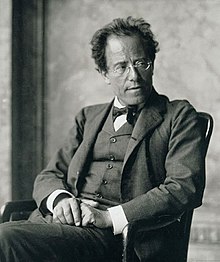Symphony No. 9 (Mahler)
| Symphony No. 9 | |
|---|---|
| by Gustav Mahler | |

Gustav Mahler in 1907
|
|
| Key | D major (-Db major) |
| Composed | 1909: Toblach |
| Published |
1912
|
| Recorded | Bruno Walter, Vienna Philharmonic Orchestra, 1938 |
| Movements | 4 |
| Premiere | |
| Date | 26 June 1912 |
| Location | Vienna |
| Conductor | Bruno Walter |
| Performers | Vienna Philharmonic Orchestra |
Symphony No. 9 by Gustav Mahler was written between 1908 and 1909, and was the last symphony that he completed. It is actually his tenth symphonic work, as Mahler gave no ordinal number (nor the title 'symphony') to his symphonic song-cycle Das Lied von der Erde.
Though the work is often described as being in the key of D major, the tonal scheme of the symphony as a whole is progressive. While the opening movement is in D major, the finale is in D♭ major.
A typical performance takes about 75 to 90 minutes.
The symphony is scored for the following orchestra:
The symphony is in four movements:
Although the symphony has the traditional number of movements, it is unusual in that the first and last are slow rather than fast. As is often the case with Mahler, one of the middle movements is a ländler.
The first movement embraces a loose sonata form. The key areas provide a continuation of the tonal juxtaposition displayed in earlier works (notably Symphonies No. 6 and No. 7). The work opens with a hesitant, syncopated rhythmic motif (which Leonard Bernstein suggested is a depiction of Mahler's irregular heartbeat), which is heard throughout the movement.
The brief introduction also presents two other ideas: a three-note motif announced by the harp that provides much of the musical basis for the rest of the movement,
and a muted horn fanfare that is also heard later.
In the development, it is heard in the horns and clarinets in Mahler's original form, with a third descending into a fifth. At the height of the development, the trombones and tuba announce the rhythmic heartbeat motif, marked within the score "Mit höchster Gewalt" (with greatest force). This has been interpreted as a sudden intrusion of "death in the midst of life", and it leads into a solemn funeral march, marked "Wie ein Kondukt" (like a funeral procession), on a timpani ostinato of the harp's three-note motif. Low bells are heard here for the first and only time in the symphony, accompanying the timpani in the three-note motif. Near the end of the movement is a remarkable example of Mahler's linear polyphony, in which piccolo, flute, oboe, and solo violin imitate bird-calls. Alban Berg asserted that this section was a "vision of the hereafter". Allusions to other music in this movement include references to Ludwig van Beethoven's Piano Sonata Op. 81a and to Johann Strauss II's waltz Freut euch des Lebens, the latter first noted by Philip Barford in 1971.
...
Wikipedia
